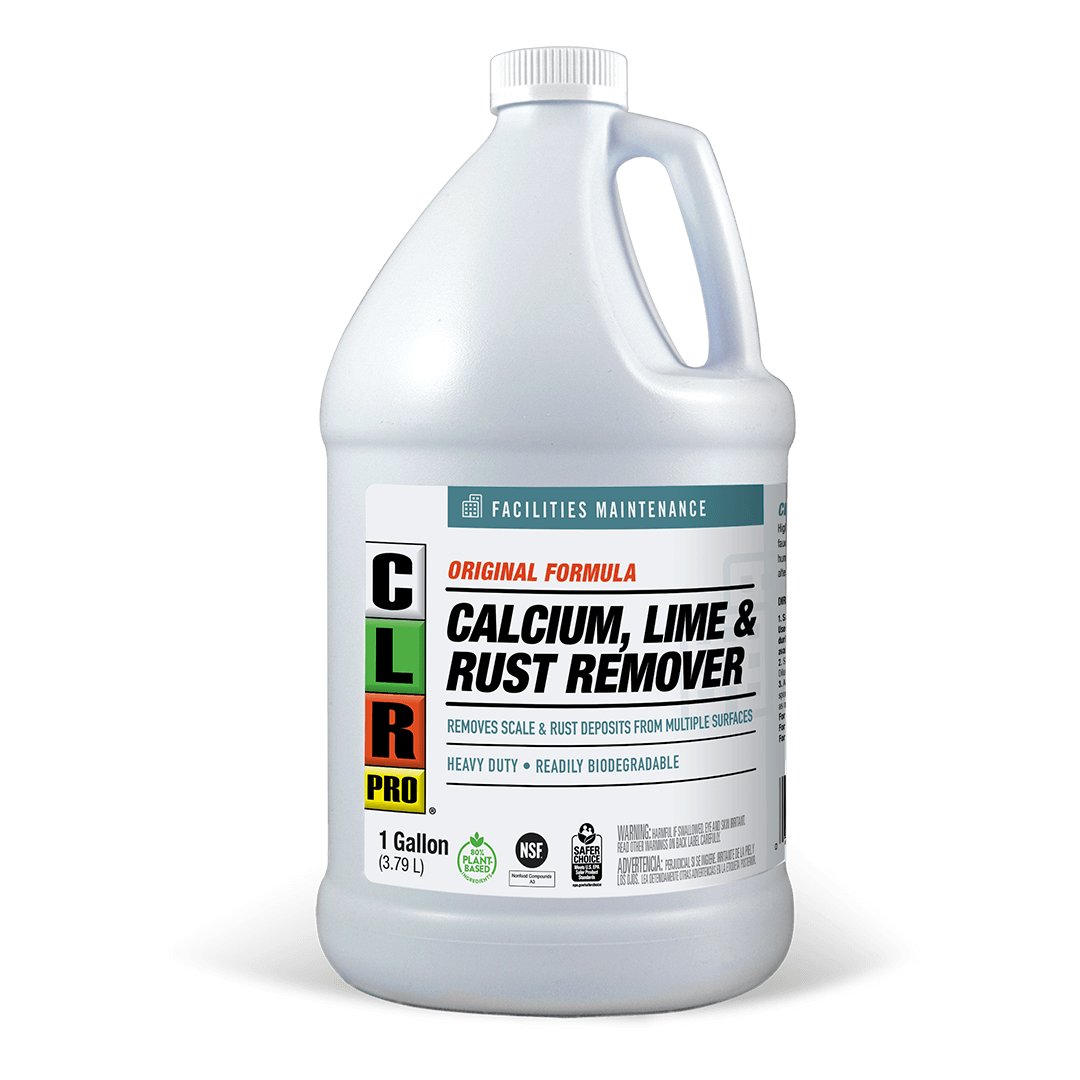
CLR PRO® Calcium Lime and Rust Remover
Fast and effective way to clean away calcium, lime and rust deposits.
- Industrial strength, multi-purpose cleaner designed for kitchen or bathroom related surfaces.
- Quickly removes calcium, lime & hard water deposits, soap scum, discoloration & dirt.
- Versatile cleaner for use on plastic, ceramic tile, glass, stainless steel, faucet and shower fixtures, shower doors, fiberglass, toilet bowls & sinks.
- Part of the EPA’s Safer Choice Program recognizing the product as a safer alternative to harsh chemicals without sacrificing the quality or product performance. Contains no phosphates, ammonia or bleach.
- Manufactured in the USA.
- NSF Registered Category A3
Available In:
For use on these surfaces
- Ceramic
- Chrome
- Glass
- Grout
- Hard plastics
- Metal
- Plastic/Resin
- Porcelain
- PVC
- Stainless Steel Exteriors
How to use this product
- Spot test on an inconspicuous area before applying.
- Apply product directly to stain. Dilution and dwell time may vary by soil load.
- Rinse promptly with cold water.
- Repeat application as necessary.
For medium soils: Mix equal parts (1:1) CLR and warm water
For heavy soils: Use full strength CLR
Featured Video
Product ingredients





| Water | Dilutent: CAS #7732-18-5 |
|
|||
| Dilutent: CAS #7732-18-5. Reverse Osmosis (RO) is a water treatment process that removes contaminants from water by passing the water through a membrane, (filter), where contaminants are filtered out yielding more pure quality water. | |||||
| Lactic Acid | Chelating Agent: CAS #79-33-4. |
|
|||
| Chelating Agent: CAS #79-33-4. Lactic acid is found in many yogurts and cheeses. It is also produced in the muscles during intense activity. Commercially, it is produced by fermentation of simple sugars. In cleaning products it functions as a chelating agent; a compound that makes metals more soluble in water. As part of the EPA Safer Choice Program, it has been evaluated and determined to be safer than traditional chemical ingredients. | |||||
| Gluconic Acid | Chelating Agent: CAS #526-95-4. |
|
|||
| Chelating Agent: CAS #526-95-4. This ingredient is an acid formed from the sugar glucose, which naturally occurs in fruit, honey and wine. It is a chelating agent; a compound that makes metals more soluble in water. As part of the EPA Safer Choice Program, it has been evaluated and determined to be safer than traditional chemical ingredients. | |||||
| Lauramine Oxide | Surfactant: CAS #1643-20-5. |
|
|||
| Surfactant: CAS #1643-20-5. Used in cleaners to modify the surface tension of water, to aid in even spreading and to allow mixing with oil and dirt so that they can be rinsed away; it is included in many soaps, detergents, and several groups of antiseptics. As part of the EPA Safer Choice Program, it has been evaluated and determined to be safer than traditional chemical ingredients. | |||||
| Tripropylene Glycol n-Butyl Ether | Solvent: CAS #55934-93-5. |
|
|||
|
Solvent: CAS #55934-93-5. Used to slow down the evaporation of many liquid products including oven cleaners and inks for ball-point and felt-tip pens. It is very effective at absorbing organic material. As part of the EPA Safer Choice Program, it has been evaluated and determined to be safer than traditional chemical ingredients. California CPRKA Designated Lists (12) US NTP Reproductive or Developmental Toxicants. https://ntp.niehs.nih.gov/publications/monographs/index.html (16) California NLs. https://oehha.ca.gov/water/notification-levels-chemicals-drinking-water (18) California TACs. https://ww3.arb.ca.gov/toxics/id/taclist.htm (20) California Non-Cancer Hazards. https://oehha.ca.gov/air/general-info/oehha-acute-8-hour-and-chronic-reference-exposure-level-rel-summary |
|||||
| Yellow No. 5 | Colorent: CAS #1934-21-0. |
|
|||
| Colorent: CAS #1934-21-0. A synthetic lemon yellow dye used all over the world, primarily as food coloring. As part of the EPA Safer Choice Program, it has been evaluated and determined to be safer than traditional chemical ingredients. | |||||
| FD&C Blue No. 1 | Colorent: CAS #3844-45-9. |
|
|||
| Colorent: CAS #3844-45-9. A blue dye used for foods and other substances. As part of the EPA Safer Choice Program, it has been evaluated and determined to be safer than traditional chemical ingredients. | |||||







